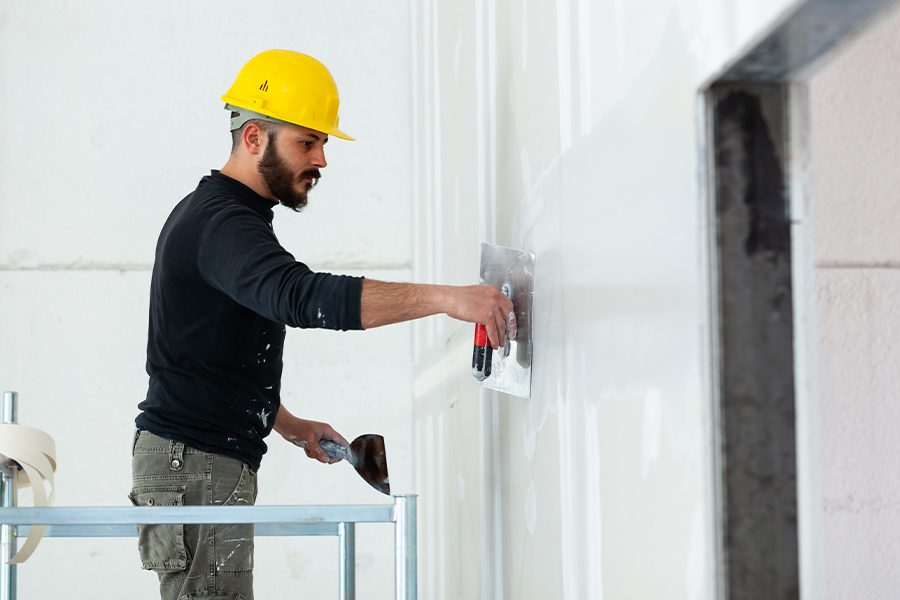Affordable Drywall Repair Options for Your Fort Worth Residential Or Commercial Property
Drywall Installment Made Easy: Tips for Perfect Results
Drywall installation is commonly perceived as an overwhelming task, yet with the best strategy and expertise, it can end up being a workable venture. Grasping methods for cutting, hanging, and ending up drywall can significantly influence the end result.
Choosing the Right Materials
Picking the proper materials for drywall installment is critical to attaining a resilient and visually pleasing surface. drywall installation. The key part, drywall sheets, usually been available in numerous densities, with 1/2-inch sheets being standard for interior wall surfaces. For locations needing added moisture resistance, such as kitchens or restrooms, take into consideration using eco-friendly board or concrete board, which are particularly created to hold up against moisture

Additionally, picking the right fasteners-- either nails or screws-- is essential for safeguarding the drywall to the framing. Drywall screws are generally preferred for their holding power and lowered threat of popping. Think about the finishing touches such as primer and paint, which not just enhance the appearance yet likewise safeguard the drywall from dampness and wear.
Preparing the Installation Location
Before beginning the drywall installation procedure, it is necessary to prepare the setup area extensively. A tidy work space minimizes the danger of damage to existing things and enables for reliable activity throughout installment.
Following, examine the walls and ceiling for any type of flaws, such as fractures, holes, or mold. Address these problems in advance; patch any type of damages and permit sufficient time for repair work to dry. Furthermore, make sure that electrical outlets, switches, and plumbing are appropriately positioned and represented, as this will certainly impact drywall placement.
Take into consideration the environmental problems. A steady temperature level and moisture degree are important for optimum adhesion and performance of the drywall products. Utilize a dehumidifier or heating system to create suitable problems. if essential.
Cutting and Hanging Drywall
The trick to reliable drywall setup lies in the accurate cutting and hanging of the panels. Use a straight edge and an energy knife to rack up the drywall along your dimensions, then break it along the racked up line for a clean break.

Constantly function from the top down and entrusted to right, making sure that you maintain a staggered pattern to enhance security. Correctly hanging the drywall sets the structure for a smooth finish, ultimately leading to remarkable lead to your drywall job.
Taping and Mudding Methods
While proper cutting and hanging of drywall sets the stage, the next crucial action includes mastering taping and mudding strategies to guarantee a seamless finish. Taping is crucial for enhancing joints and protecting against cracks; it entails installing tape into the used joint substance (mud) Beginning useful content with a high quality fiberglass or paper tape, using the tape over the joint and pressing it right into the wet mud utilizing a taping blade, making sure no air bubbles remain.
When the tape remains in location, use a thin layer of joint compound over the tape, feathering the sides to develop a smooth transition to the drywall surface area. Enable this layer to completely dry totally before sanding it lightly to remove imperfections. Repeat this procedure, using extra coats of mud as required-- typically 2 to three coats-- while gradually expanding the application area with each layer to achieve a smooth look.
After the final coat dries out, over here sand the surface area with a fine-grit sandpaper up until smooth. sheetrock repair fort worth. Remember to wear a mask during sanding to avoid breathing in dust particles. Mastering these taping and mudding methods is critical for attaining a professional-quality finish in your drywall setup
Finishing Touches for Excellence
Attaining a perfect drywall installment goes beyond taping and mudding; it culminates in the finishing touches that raise the total look. These final steps are critical in making sure a professional-grade finish that improves the visual appeals of your space.
Begin by sanding the dried out joint substance to produce a smooth surface area. Make use of a fine-grit sandpaper and a sanding block or pole sander for optimum control. Pay particular attention to edges and edges, as these locations have a tendency to call for more thorough work. After fining sand, clean down the wall surfaces with a damp fabric to eliminate any type of dust bits, guaranteeing a tidy surface area for paint.
Next, apply a primer particularly made for drywall. This step is vital, as it helps secure the joint compound and gives a consistent base for the overcoat. As soon as the primer dries out, examine for any kind of blemishes, and repair as needed.
Conclusion
In verdict, effective drywall setup pivots on the cautious choice of materials, detailed preparation of the installation area, and specific execution of reducing and hanging techniques. Proficiency of taping and mudding procedures is necessary for attaining a smooth finish.
Drywall installment is commonly perceived as a difficult job, yet with the appropriate technique and knowledge, it can come to be a workable venture.Selecting the proper materials for drywall installment is vital to accomplishing a durable and aesthetically pleasing finish.Prior to beginning the drywall setup process, it is necessary to prepare the installation area extensively. Mastering these taping and mudding strategies is crucial for attaining a professional-quality finish in your drywall installation.
In verdict, successful drywall setup pivots on the mindful choice of materials, detailed preparation of the installment location, and exact execution of cutting and hanging techniques.